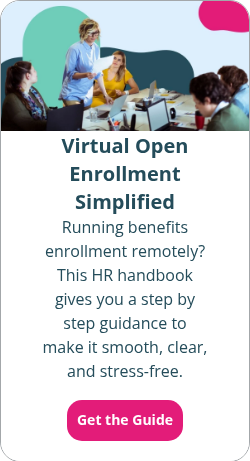How to correctly enroll in Medicare
By Elizabeth Walker on June 11, 2025 at 9:00 AM
Enrolling in Medicare can feel overwhelming. Understanding the different Medicare Parts, enrollment periods, and the potential late fees can make you unsure about the best ways to proceed. Whether you’re nearing retirement, leaving an employer-sponsored group plan, or helping a loved one make the switch, you must know how to enroll in coverage properly.
This article provides step-by-step instructions for enrolling in Medicare so you can get the health coverage you need without incurring costly fines or headaches.
In this blog post, you’ll learn:
- When and how to enroll in Medicare to avoid late penalties and ensure continuous coverage
- What each part of Medicare covers so you can choose the right combination of coverage for your healthcare needs.
- Tips for coordinating Medicare with an individual coverage health reimbursement arrangement (ICHRA).
What is Medicare?
Medicare is a federal health insurance program for individuals 65 and older. You may be eligible earlier than age 65 if you have a qualifying disability. This includes end-stage renal disease (ESRD), ALS, or if you’ve received Social Security Disability Insurance benefits for at least 24 months.
Some people are automatically enrolled in Medicare, while others need to actively sign up for coverage. Automatic enrollment typically depends on whether you received Social Security disability or retirement benefits before your 65th birthday.
Many individuals confuse Medicare and Medicaid, but they’re not the same. The Centers for Medicare & Medicaid Services (CMS) manage both health insurance programs, but they support different groups1. Medicaid eligibility depends on income and provides coverage to people with limited financial resources.
In contrast, Medicare eligibility depends on age or disability status. But your income may impact your premium costs for certain parts of coverage.
Below are the four main parts of Medicare coverage:
- Part A is the hospital insurance section of Original Medicare. It covers hospital-related services, such as inpatient stays, hospice care, and skilled nursing facilities.
- Part B is the medical insurance section of Original Medicare. It helps pay for outpatient care, such as doctor visits, preventive healthcare, laboratory tests, and medical supplies.
- Part C, known as the Medicare Advantage program, is sold by private health insurers and covers everything included in Parts A and B. Some Part C plans can also help pay for prescription drug costs and vision or dental care.
- Part D is an optional prescription drug plan. These plans must offer you at least two medication choices in each drug category to treat your condition.
Five key steps to enroll in Medicare correctly
Before you jump in and enroll in Medicare coverage, you must understand the basics of the process. The following five steps will help get you started.
Step 1: Determine if you’re eligible for coverage
Most people qualify for Medicare when they turn 65. If you have a qualifying disability, you may be eligible before age 65.
The federal government will automatically enroll you in Medicare Part A and B if you're already collecting Social Security benefits. If you're not receiving Social Security yet, you must sign up on your own. In this case, enrollment isn’t automatic, and you won’t get a reminder notice in the mail. So, keeping track of when you can apply is key.
Step 2: Know the various enrollment times
Knowing when you can sign up is essential to avoiding late enrollment fees or having a coverage gap when you need medical care.
Here are the three enrollment periods:
- Initial enrollment period. You can enroll in Medicare at age 65 during your initial enrollment period. This seven-month timeframe begins three months before your 65th birthday and ends three months after. You won’t have to pay any penalties if you enroll during this window.
- Annual enrollment period. The period runs from October 15th to December 7th each year. During this time, individuals with Medicare coverage can review and change their plan for the following year so that coverage starts on January 1. This is not the time for enrolling in Medicare for the first time.
- You’ll pay an extra 1% each month that you don’t enroll in a Part D plan when you first get Medicare or go 63 days or more without a reasonable prescription drug plan.
- Special enrollment period. Certain qualifying events trigger a special enrollment period. For example, you’ll qualify if you’ve already turned 65 but delayed enrolling in Medicare because you or your spouse had an employer group health plan. You can enroll in Medicare without penalty while still covered by that group health plan, or within eight months after coverage or employment ends.
- General enrollment period. If you missed the other periods and don’t qualify for a special enrollment period, you can enroll annually between January 1 and March 31. But enrolling in Part B during this period results in a 10% late enrollment penalty for each full year that you didn’t enroll, in addition to your regular monthly premium.
Step 3: Consider what Medicare Parts you need
Before signing up, you must think about which parts of Medicare best suit your needs.
Medicare Parts A and B cover many essential healthcare services. But it doesn’t pay for everything. For example, routine dental services, vision exams, and hearing aids aren’t covered, plus you’re responsible for any deductibles, copays, and coinsurance. If you need help paying for these out-of-pocket expenses, you can add a Medigap supplemental policy for an extra cost.
To roll everything in one package, you may consider buying a Medicare Advantage Part C plan from a private insurance company. These bundled plans include Part A and Part B benefits, and many cover Part D expenses. However, Medigap policies don’t cover Part C plan costs.
You can compare and shop for plans using the plan finder tool at Medicare.gov2. You can also work with a licensed agent or broker, or buy coverage directly through a private insurance company that offers Medicare Advantage.
Step 4: Apply for Medicare coverage
If you don’t meet the requirements for automatic Medicare enrollment, you must apply for Medicare when eligible.
Here are your three options:
- Online. The fastest way to apply is online through the Social Security Administration’s website. The process usually takes less than 30 minutes, and you’ll receive a confirmation number to check the status of your application after submission.
- Phone. You can call the SSA at 1-800-772-1213 to apply over the phone or set up an appointment. This method takes longer, as you’ll need to wait for the necessary forms to arrive in the mail so you can fill out and sign your application.
- In-person. Your last option is to visit your local Social Security Administration office. This may be a smart option if your 65th birthday is coming up and you want your application processed as soon as possible. You can use the SSA’s office locator to find one near you4.
Once you choose your preferred enrollment method, gather the following documents:
- Your original birth certificate to prove your age
- Proof of U.S. citizenship or legal residency, such as a passport
- Your Social Security card
- Details about any current health plans
- Proof of employment history, such as a W-2 form
- You or your spouse must have worked and paid Medicare taxes for at least 10 years to be able to apply for premium-free Part A coverage.
- Military service history, if you receive military or veteran benefits
- Previous Social Security benefit payments
- Marriage information, such as your spouse's employment and health coverage history
Step 5: Get your Medicare card, and enjoy your benefits
Once you complete enrollment, your Medicare card will arrive in the mail, typically within three to four weeks. If you enrolled in a Medicare Advantage plan, you’ll get a separate card directly from your insurance provider.
You can start using your benefits after receiving your cards. Keep them in a safe place to get the most out of your Medicare coverage when you seek healthcare.
Can I participate in an individual coverage HRA (ICHRA) if I have Medicare?
The individual coverage HRA (ICHRA) is a health benefit your employer can offer that allows you to receive tax-free reimbursement for individual health plan premiums and other qualified out-of-pocket costs. Parts A, B, C, D, and Medigap plan premiums are all eligible for reimbursement with an ICHRA.
You may be eligible to use an ICHRA if you have Medicare coverage. It depends on your Medicare type and whether you meet certain conditions. You and your covered dependents must have a qualifying individual health plan that provides minimum essential coverage (MEC) to participate in an ICHRA. Having Medicare Parts A and B or Medicare Part C qualifies as MEC.
Here’s how the different parts of Medicare work with an ICHRA:
- Part A. Part A works with the ICHRA as long as you pair it with Part B coverage. You can get your Part A premiums reimbursed if you’ve enrolled on your own. But if the federal government automatically enrolled you in Medicare, the IRS doesn’t consider the Part A payroll tax an eligible expense for reimbursement through an ICHRA.
- Part B. You must have Part A coverage to use an ICHRA with Part B. This is because Part B doesn't provide MEC on its own.
- Part C: Part C is fully compatible with an ICHRA and counts as MEC with no extra requirements.
- Part D: Having Part D alone doesn’t meet MEC standards for participating in the ICHRA. You must have other qualifying coverage (like Parts A and B or Part C) to receive reimbursements for your Part D premiums.
Learn more in our article on ICHRA and Medicare.
Conclusion
Enrolling in Medicare may feel daunting. But by reviewing the above steps carefully, the task becomes much easier. Understanding the ins and outs of Medicare can help you avoid costly penalties and make confident enrollment choices. Plus, if your employer offers you an ICHRA, you can make your Medicare premium even more affordable.
This article was originally published on November 11, 2016. It was last updated on June 11, 2025.
Check out more resources
See these related articles

ICHRA administration for first-timers
Learn the basics of ICHRA administration for first-timers. Discover setup steps, compliance tips, and how to manage reimbursements effectively.

What is an annual out-of-pocket maximum?
Learn what an annual out-of-pocket maximum is, how it limits your healthcare costs, and what expenses count toward this insurance cap.

Health insurance reimbursements: What are the options?
Explore your options for health insurance reimbursement. Understand what insurance reimbursement means and how HRAs can support employees.



